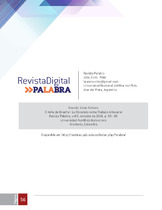| dc.contributor.author | Branda, Silvia Adriana | |
| dc.coverage.spatial | Seccional Medellín | spa |
| dc.date.accessioned | 2020-12-02T20:45:49Z | |
| dc.date.available | 2020-12-02T20:45:49Z | |
| dc.date.issued | 2018 | |
| dc.identifier.uri | http://hdl.handle.net/20.500.11912/6932 | |
| dc.description | p. 56 - 65 | spa |
| dc.description.abstract | El Sociólogo norteamericano Richard Sennett (2009) explica que la artesanía es la habilidad de hacer las cosas bien y está activada por un impulso humano duradero y básico: el deseo de realizar adecuadamente una tarea. Desde esta mirada, el término es más abarcativo que el estrictamente referido al trabajo manual especializado, se aplica a muchas profesiones y a oficios y suele retribuir al individuo con el orgullo por la labor realizada. Todo buen artesano, continúa Sennett, mantiene un diálogo entre sus prácticas concretas y sus pensamientos, que evolucionan juntos hasta convertirse en hábito. De esta manera, el concepto del artesano va más allá y representa en cada uno de nosotros el deseo de hacer algo bien, concretamente y sin ninguna otra finalidad. En este trabajo se explorarán distintos conceptos como: artesanía, motivación, habilidad, despertar, pericia, vocación y orgullo por el trabajo propio. Se trazará así un camino que permita visualizar las prácticas docentes de los profesores universitarios en un marco particular, el de la artesanía. | spa |
| dc.description.abstract | American Sociologist Richard Sennett (2009) explains that craftsmanship is the ability to do things right and is driven by a basic human impulse: the desire to perform a task properly. From this perspective, the term is more comprehensive than the one strictly based on the specialized manual labor; it applies to many professions and jobs and it usually rewards the individuals with pride in their work. Every good craftsman, adds Sennett, keeps a dialogue between his specific practices and his thoughts, which evolve together to become habit. Thus, the concept goes beyond the artisan and represents our desire to do something right, namely without any other purpose. This paper will explore various concepts: craftsmanship, motivation, ability, awake- ning, expertise, dedication and pride in one’s work. Thus, it traces a path that allows us to visualize the teaching practices of university professors in a particular frame, crafts. | spa |
| dc.format.mimetype | application/pdf | |
| dc.language.iso | spa | |
| dc.publisher | Universidad Pontificia Bolivariana | spa |
| dc.relation.ispartof | Revista Digital Palabra | spa |
| dc.rights | Attribution-NonCommercial-NoDerivatives 4.0 International | * |
| dc.rights.uri | http://creativecommons.org/licenses/by-nc-nd/4.0/ | * |
| dc.subject | Artesanía | spa |
| dc.subject | Práctica docente | spa |
| dc.subject | Motivación | spa |
| dc.subject | Crafts | spa |
| dc.subject | Teaching practices | spa |
| dc.subject | Motivation | spa |
| dc.title | El Arte de Enseñar: La Docencia como Trabajo Artesanal | spa |
| dc.type | article | spa |
| dc.rights.accessRights | openAccess | spa |
| dc.type.hasVersion | publishedVersion | spa |
| dc.description.sectional | Medellín | spa |
| dc.identifier.instname | instname:Universidad Pontificia Bolivariana | spa |
| dc.identifier.reponame | reponame:Repositorio Institucional de la Universidad Pontificia Bolivariana | spa |
| dc.identifier.repourl | repourl:https://repository.unab.edu.co/ | |


